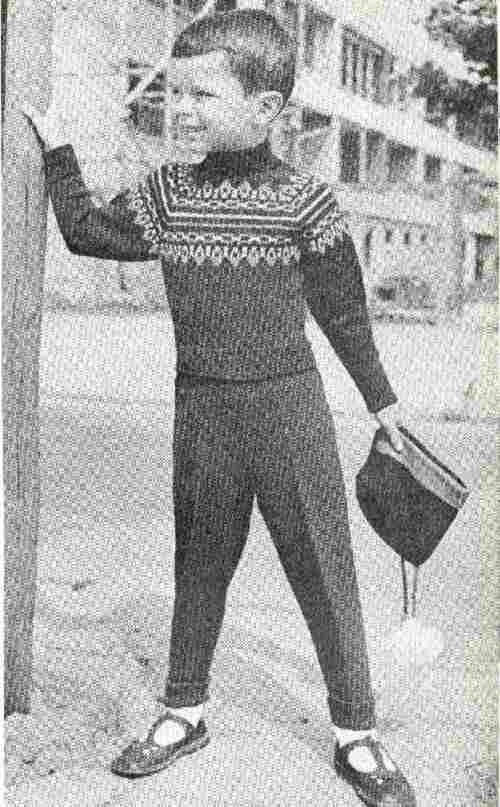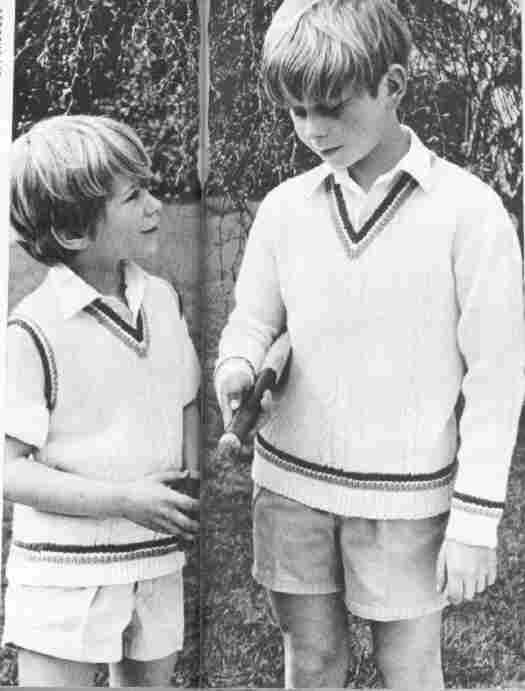
Figure 1.--This Dutch boys wears a Alpine-type pullover with knit pants and sandals. I think he is holding a cap with pom-poms. Note the English-style school sandals that the boy is wearing.


Figure 1.--This Dutch boys wears a Alpine-type pullover with knit pants and sandals. I think he is holding a cap with pom-poms. Note the English-style school sandals that the boy is wearing. |
The Dutch winters can be quite cold. There are also a lot of chilly spring and autumn days, located as the Dutch are on the North Sea. Thus sweaters have proven to be very popular garments in the Netherlands. I'm not sure when Dutch boys began wearing sweaters, but they are clearly being comnonly worn by the 1920s (surely appearing much earlier). They are still very popular today. HBC has, however, little information on sweater styles and patterns.
The Dutch winters can be quite cold. There are also a lot of chilly spring and autumn days, located as the Dutch are on the North Sea. Thus sweaters have proven to be very popular garments in the Netherlands. Layered with other garments and perhaps a scarf, a sweater can be quite a warm garment.
I'm not sure when Dutch boys began wearing sweaters, but they are clearly being comnonly worn by the 1920s (surely appearing much earlier). HBC believes that they probably appeared in the late 19th century. They are still very popular today.
The Dutch word for sweaters is "trui". I'm not sire what terms were used for the different styles of sweaters.
HBC has little information on Dutch sweater styles. Most of the sweaters worn by Dutch boys appear to have been pullovers. Many of the images HBC has seen have had crew necks. Dutch boys have also worn turtle-neck sweaters. The "V"-neck sweatrers so common in England were also worn by Dutch boys, but not as commonly. Boys wore both sleeveless and sleeved "V" necks. Some "V"-necks had British school styling, that is colored trim around the neck and cuffs. Cardigans were also commonly worn after World War II, but were not as popular a style as pullovers.
HBC does not yet have any information on the colors of sweaters worn by Dutch boys.
Dutch boys wore a wide variety of patterned sweaters. Patterns can be made in both different colors as well as the same color with variations in knitting to provide a less pronounced pattern. The solid-colored flat-weave sweater so common in England do not seem to have been as popular in the Netherlands. Dutch mothers weaving sweaters apparently wantedf to introduce some color and destinctive design elements. We are less sure about what the boys thought or indeed if they even noticed the different patterns to any extent. HBC has, however, only limited information on patterns at this time.
Many European boys during the 1920s began wearing sweaters, which tended to to be made longer than now, over their pants--usuallly short pants. We have observed this convention in Belgium, France, Germany, and the Netherlands as well as other countries. We do not know why this convention developed. Later the swearters became more shorter and were cut at the waist and often tucked inside the pants.

Figure 2.--These Dutch brothers wear coordinated "V"-neck pullovers. The sweaters have English-like school trim, contrasting colors around the neck and other edges. One of the boy even carries a cricket bat--despite cricket not being very popular in the Netherlands. |
Dutch boys wear sweaters on virtually all occasions. They wore them around the home for play during cool weather. They also commonly wore them inside the home. Until the late 20th century, few Dutch homes had central heating so boys commonly wore their sweaters inside the home. Sweaters were also commonly worn to school, during the winter with a jacket and sacrf. Schools like homes were not well heated until the late 20th century.
Some available images shows brothers being dressed in idetical or coordinate sweaters. This appears to have been popular in the post-World War II era--at least in fashion magazines and clothing catalogs. HBC is not sure how common it was among Dutch boys.
Sweaters were originally wool garments. Well into the post-World War II era, most Dutch boys wore wool sweaters. Wool is, however, a rather expensive material. Many boys now wear sweaters made out of synthetic fibers.
Navigate the Boys' Historical Clothing Web Site:
[Introduction]
[Activities]
[Biographies]
[Chronology]
[Clothing styles]
[Countries]
[Bibliographies]
[Contributions]
[FAQs]
[Glossaries]
[Satellite sites]
[Tools]
[Boys' Clothing Home]
Navigate the Boys' Historical Clothing Dutch pages:
[Return to the Main Dutch boys' garment page]
[Maiken Island]
[Dutch choirs]
[Dutch scouts]
[Dutch school uniform]
[Dutch boys bangs]
Navigate the Boys' Historical Clothing national pages:
[Return to the Main Dutch page]
[Australia]
[Belgium]
[England]
[France]
[Germany]
[Ireland]
[Italy]
[Japan]
[Korea]
[Mexico]
[Netherlands]
[Scotland]
[United States]
